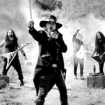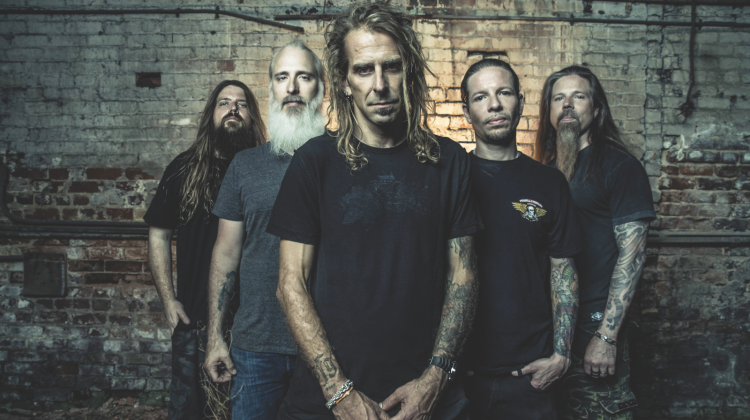While Ministry's 1986 album Twitch marked the group's transformation from a lightweight new wave pop band into a dark, corrosive industrial outfit, it was 1988's The Land of Rape and Honey that featured the band's first use of distorted guitar sounds and took Ministry in a heavier, more headbanging direction.
Even though the hooky three-chord riff on the record's most iconic song, "Stigmata," was played with sampled guitars and a pitch shifter, the record still pulsed with metallic malevolence. "Deity," another fan favorite, features chunky, palm-muted riffage, thrash beats and an actual guitar solo; Ministry also used real guitars to create texture and dissonance on other tracks.
Though most of the record relied on electronic weapons of mass destruction, Rape and Honey was a marked step toward the full-on industrial metal of classic LPs like The Mind Is a Terrible Thing to Taste and Psalm 69. The slamming beats, brooding bass, movie samples, dread-inducing keyboards and misanthropic lyrics make The Land of Rape and Honey one of the highlights of Ministry's voluminous catalog in its own right.
Frontman Al Jourgensen has spoken about his distaste for most Ministry albums, claiming he prefers to look towards the future than reaching back into the past. Even so, he still enjoys The Land of Rape and Honey and the way he and the artists he worked with on the album converted complete chaos into breathtaking art.
"For most of the album, we bulk-recorded a bunch of shit. If you listened to it right then, it sounded like snippets of noise," Jourgensen wrote in his memoir, Ministry: The Lost Gospels According to Al Jourgensen. "People think there's rhyme and reason to what I do, but almost everything is plucked out of thin air. It's almost like these passages are transmitted to me in my sleep, and when I wake up I go and get my engineer so we can translate what I just heard in my head."
Jourgensen and his then–music partner Paul Barker worked on The Land of Rape and Honey when the former was in the throes of heroin addiction. At times, it made Jourgensen as prolific as Frank Zappa. At other moments, the drugs rendered him practically incoherent. Yet when he could navigate through the haze, Jourgensen and Barker were able to create a thrilling nightmare soundscape of decadence, aggression and anarchy that warned against the still-relevant dangers of fascism, organized religion and the restriction of free expression. "As much as I like this record, it's kind of a shame that some of the same topics I was railing about then are still pertinent now," Jourgensen recently said. "Time flies, but nothing changes."
Considering what a wreck Jourgensen was during the creation of The Land of Rape and Honey and the tour that followed, it's amazing he survived at all to see how resonant the album's themes still are today. Below are eight examples of the weird and wild shit Jourgensen experienced and experimented with during the cycle for The Land of Rape and Honey.
Al Jourgensen and his wife/manager let life slip away looking for way more than just one fix
While Ministry were supposed to be working on The Land of Rape and Honey, Al Jourgensen's wife and manager Patty was in no position to motivate her husband to get in the studio and be productive. After all, they never knew what time the dope man would deliver their goods. "Our whole lives revolved around these losers' schedules when they could make it to the house or the studio," wrote Al Jourgensen. "Sometimes I'd wait for hours and hours. I was shooting up eight to 10 times a day by that point. I realized I was a full-blown junkie because if I didn't get it that day or if my dealer was late, I'd be freaking out and shaking and throwing up."
Jourgensen crashes his new motorcycle while on Quaaludes
Since he didn't have a car, Jourgensen bought a motorcycle from Wax Trax! owner Jim Nash. The bike wasn't made for a beginner, which the Ministry main man was. The vehicle was heavy, clunky and hard to keep upright. A week after he bought it, Jourgensen took a bunch of Quaaludes and drove down Lakeshore Drive in Chicago. "I was cutting through the lanes of traffic when I blew my balance and lost control," he wrote. "The bike tipped over with me still on it. I skidded for about 500 feet, getting road rash up and down my back and thighs. I was hamburger meat. It hurt like hell, but I couldn't do anything about it until I stopped sliding."
Jourgensen crashes his bike again — a week later
Just a week after his first motorcycle crash, Jourgensen took the bike out for another spin. He left his house and stopped at a red light. By this time, he had learned how to keep the bike upright, turn and brake, so he might have been safe on the road if he hadn't nearly been rear-ended. "This truck moved forward, but then suddenly the driver slammed on his breaks," Jourgensen wrote. 'I revved the bike right into the back of the truck's bumper and went flying off like a human projectile. I flew straight through a Chicago Tribune newspaper vending box, helmet first. And I couldn't get my head out of the box. I was stuck like a miserable cartoon character."
Ministry name the album after the offensively misguided motto of a small Canadian town
Until late 2016, the town of Tisdale in northern Saskatchewan's welcome sign read, "Welcome to Tisdale Land of Rape and Honey." When Al Jourgensen saw the slogan on a souvenir mug he knew he had found the name of Ministry's third studio album. While Jourgensen loved the saying, many who passed through Tisdale over the years were offended by the title and complained about it — which explains why the motto was eventually changed to "Tisdale: Opportunity Grows Here." So why was Tisdale known as the Land of Rape and Honey for 60 years? The name refers to the town's once popular exports, a yellow oilseed called rape or rapeseed and, well, honey. In 2015, Tisdale surveyed its residents to find out how they felt about the "Rape" slogan and those who wanted to keep it were outvoted. "There's some residents who feel I should be educating people on what rapeseed is [rather than considering a slogan change]," the town's economic director Sean Wallace told The Independent.
Jourgensen takes William Burroughs' cut-up method to new, weirder, urine-stained heights
When all the rhythm tracks were recorded for a song, Jourgensen used a grease pencil to mark the location of each beat on the reel-to-reel tape Ministry were using to record. Then he chopped up the tape into equal-sized pieces, tossed them on the floor and scrambled them around before reassembling them in random order. "When I picked them up I didn't know if they were forward or backward," he wrote. "So, in a way, it was like musical Russian roulette. I'd listen to [what I'd put together] and if it sounded good — which it did a lot of the time — I'd keep it. If it wasn't right, I'd chop it up again and keep experimenting ... I'd rub some of the pieces of tape in coffee, others had cigarette burns or urine stains."
The album art could have been the head of a decapitated deer
The digitally distorted image on the cover of The Land of Rape and Honey is a shot of the Buchenwald concentration camp, a still of which Jourgensen pulled from a documentary about the Holocaust. It looks kinda like a freaky, psychedelic, computer-generated blob. But word traveled fast and when the Sire Records heads Seymour Stein and Howie Klein found out what the shot depicted, they rejected the cover and asked the band to come up with something else. "I said, 'OK, I've got another cover for you,'" wrote Jourgensen. "I found some roadkill — a run-over deer — cut off the head, put it in my truck and drove 12 hundred miles from Austin to Los Angeles ... I went into the Sire office building with the deer head, threw it on the desk of the head of the art department and said, 'Here's your new fucking cover.' All of a sudden we got our old cover back."
Ministry fight Nazis who completely misconstrue their message
Lunkheaded Neo-Nazis failed to grasp Ministry's anti-fascist messages. Those who found out what the cover art depicted celebrated, and when they heard the "Sieg Heil" samples in the title track, they mistakenly embraced Ministry as like-minded bigots. "All of a sudden we're their favorite band, and as soon as we start playing there are Nazi skinheads ready to fight everyone in the pit," Jourgensen recalled. "I'd have to konk them on the head with a bottle of Bushmills, wasting precious, precious whiskey."
Skinny Puppy and Ministry discover they're brothers in blood — and freak out k.d. lang in the process
During shows, Jourgensen sometimes cut himself onstage, in his words, "to feel more alive." He'd bleed onstage, on the way backstage, and leave bloodstains in the dressing rooms. At a certain point in the tour, the band noticed that when they arrived at the club they were scheduled to perform in, there was already blood trails around the facility. It turned out that Skinny Puppy, who uses gallons of fake blood in concert, were crossing paths with Ministry's tour. The two groups finally met in Los Angeles and were united by Skinny Puppy vocalist Nivek Ogre. "'So you're the one who's leaving blood all over the dressing room?'" Jourgensen recalls Ogre asking. "I said, "You're leaving fake blood everywhere and I'm getting it on my boots and slipping on it backstage," replied Jourgensen. "We laughed about that and then we started talking about music, road stories and drugs," he wrote. "We realized we had a lot in common and we became good friends ... Ogre asked me if I would produce the next Skinny Puppy record and I thought it was a great idea ... k.d. lang was in the studio next to us and we freaked her out right away because of the way we looked. I knew right away there was a bad vibe, but sometimes bad vibes make for great, tension-filled music."
Jon Wiederhorn is the co-author of Louder Than Hell: The Definitive Oral History of Metal, as well as the co-author of Scott Ian's autobiography I'm the Man: The Story of That Guy From Anthrax, Al Jourgensen's memoir Ministry: The Lost Gospels According to Al Jourgensen and Agnostic Front singer Roger Miret's My Riot! Grit, Guts and Glory.










